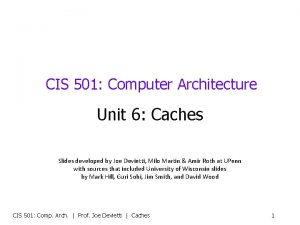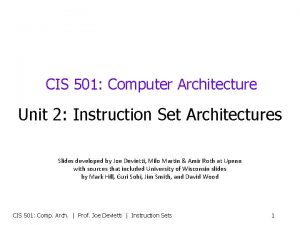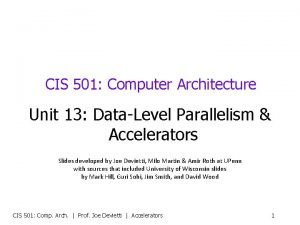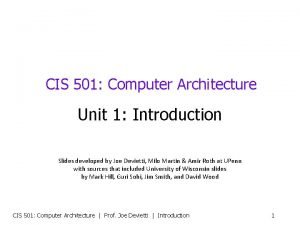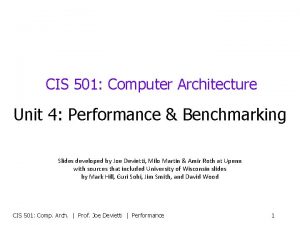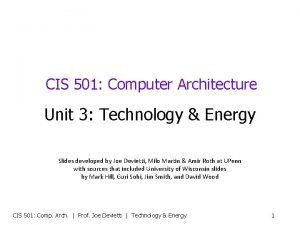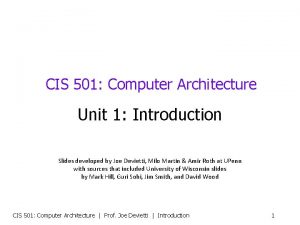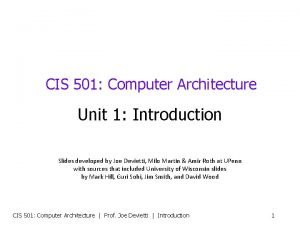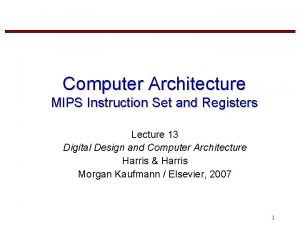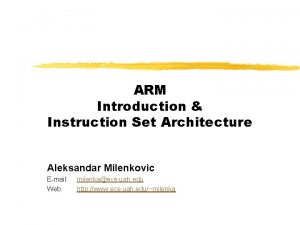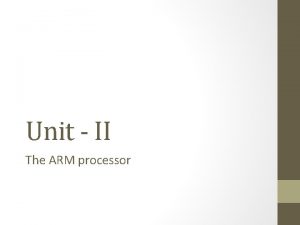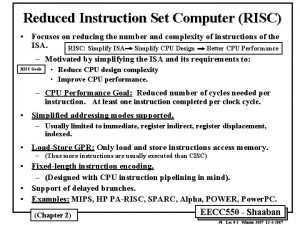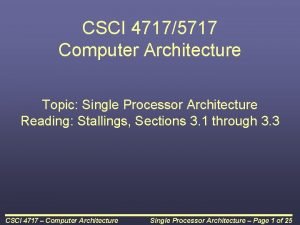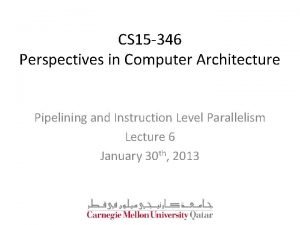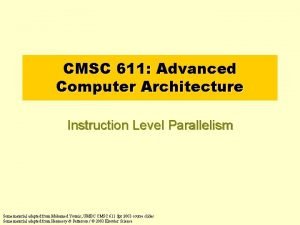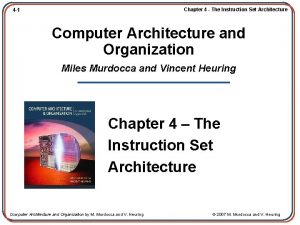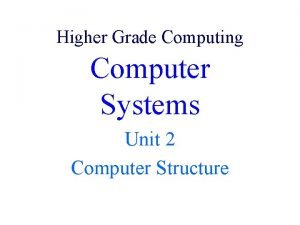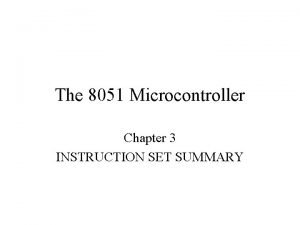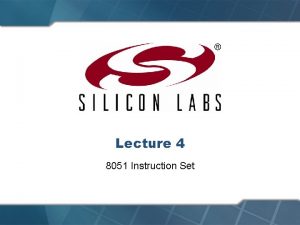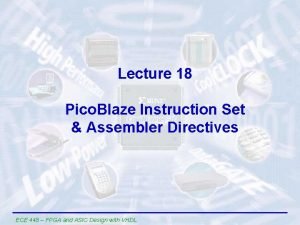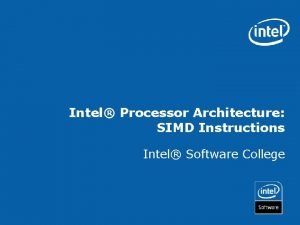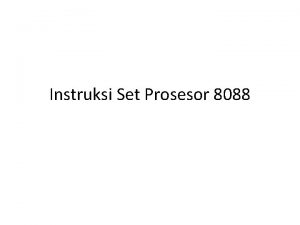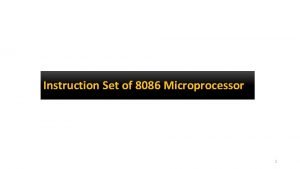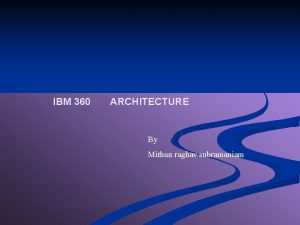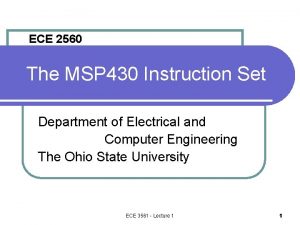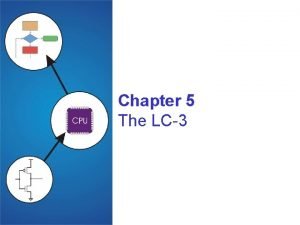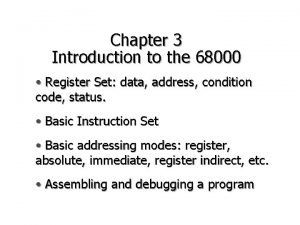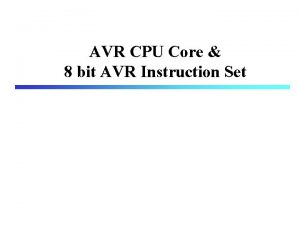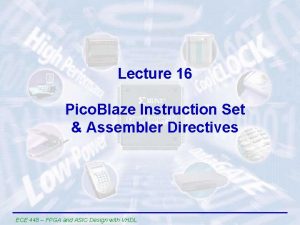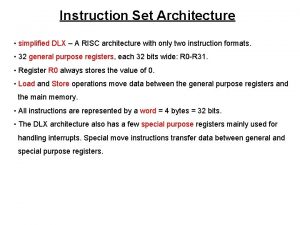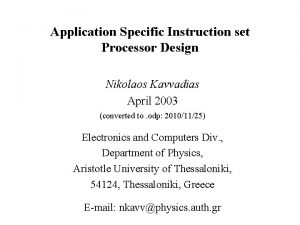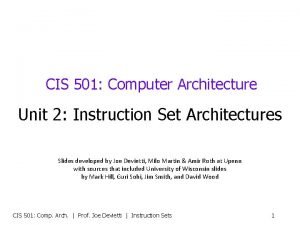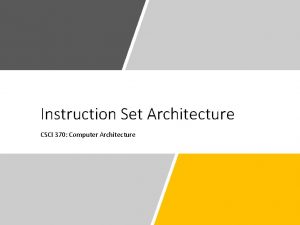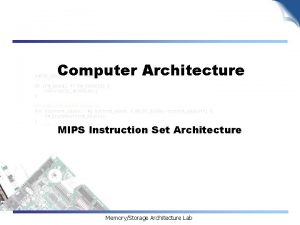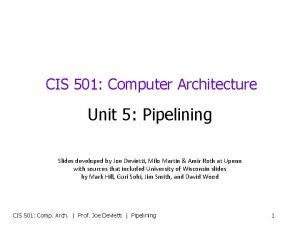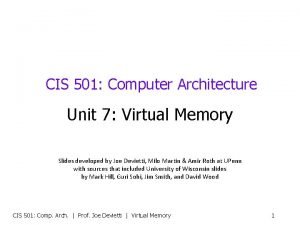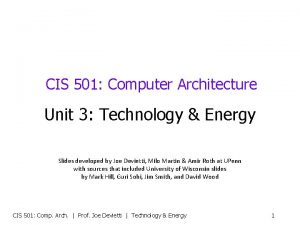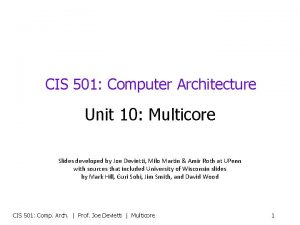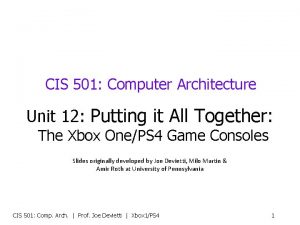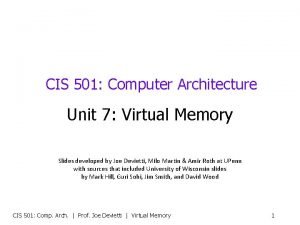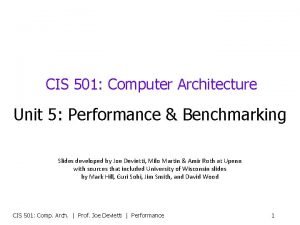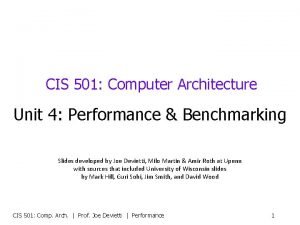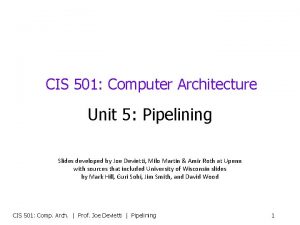CIS 501 Computer Architecture Unit 2 Instruction Set



![Program Compilation App App System software Mem CPU I/O int array[100], sum; void array_sum() Program Compilation App App System software Mem CPU I/O int array[100], sum; void array_sum()](https://slidetodoc.com/presentation_image_h/780551627034106017ce9f0622cc5ead/image-4.jpg)




















![Length and Format • Length Fetch[PC] Decode Read Inputs Execute Write Output Next PC Length and Format • Length Fetch[PC] Decode Read Inputs Execute Write Output Next PC](https://slidetodoc.com/presentation_image_h/780551627034106017ce9f0622cc5ead/image-25.jpg)

































- Slides: 58

CIS 501: Computer Architecture Unit 2: Instruction Set Architectures Slides developed by Joe Devietti, Milo Martin & Amir Roth at Upenn with sources that included University of Wisconsin slides by Mark Hill, Guri Sohi, Jim Smith, and David Wood CIS 501: Comp. Arch. | Prof. Joe Devietti | Instruction Sets 1

Instruction Set Architecture (ISA) • What is an ISA? Application OS Compiler CPU • A functional contract Firmware I/O Memory Digital Circuits Gates & Transistors • All ISAs similar in high-level ways • But many design choices in details • Two “philosophies”: CISC/RISC • Difference is blurring • Good ISA… • Enables high-performance • At least doesn’t get in the way • Compatibility is a powerful force • Tricks: binary translation, m. ISAs CIS 501: Comp. Arch. | Prof. Joe Devietti | Instruction Sets 2

Execution Model CIS 501: Comp. Arch. | Prof. Joe Devietti | Instruction Sets 3
![Program Compilation App App System software Mem CPU IO int array100 sum void arraysum Program Compilation App App System software Mem CPU I/O int array[100], sum; void array_sum()](https://slidetodoc.com/presentation_image_h/780551627034106017ce9f0622cc5ead/image-4.jpg)
Program Compilation App App System software Mem CPU I/O int array[100], sum; void array_sum() { for (int i=0; i<100; i++) { sum += array[i]; } } • Program written in a “high-level” programming language • C, C++, Java, C# • Hierarchical, structured control: loops, functions, conditionals • Hierarchical, structured data: scalars, arrays, pointers, structures • Compiler: translates program to assembly • Parsing and straight-forward translation • Compiler also optimizes • Compiler is itself a program…who compiled the compiler? CIS 501: Comp. Arch. | Prof. Joe Devietti | Instruction Sets 4

Assembly & Machine Language App App Machine code Assembly code System software Mem CPU I/O • Assembly language • Human-readable representation • Machine language • Machine-readable representation • 1 s and 0 s (often displayed in “hex”) • Assembler x 9 A 00 x 9200 x. D 320 x 9464 x. D 520 x 6640 x 6880 x 18 C 4 x 7880 x 1261 x 1 BA 1 x 2 B 64 x 03 F 8 CONST R 5, #0 CONST R 1, array HICONST R 1, array CONST R 2, sum HICONST R 2, sum LDR R 3, R 1, #0 LDR R 4, R 2, #0 ADD R 4, R 3, R 4 STR R 4, R 2, #0 ADD R 1, #1 ADD R 5, #1 CMPI R 5, #100 BRn array_sum_loop • Translates assembly to machine Example is in “LC 4” a toy instruction set architecture, or ISA CIS 501: Comp. Arch. | Prof. Joe Devietti | Instruction Sets 5

Example Assembly Language & ISA App App System software Mem CPU I/O • ARM: example of real ISA • 32/64 -bit operations • 32 -bit insns • 63 registers • 31 integer, 32 floating point • ~100 different insns Example code is ARM, but all ISAs are pretty similar CIS 501: Comp. Arch. | Prof. Joe Devietti | Instruction Sets cmp r 1, #0 push ble movs subs mov. L 3: adds ldr cmp add bne. L 2: pop bx. L 4: movs b. L 2 {r 4}. L 4 r 3, #0 r 2, r 0, #4 r 0, r 3, #1 r 4, [r 2, #4]! r 3, r 1 r 0, r 4. L 3 {r 4} lr r 0, #0 6

Instruction Execution Model App App System software Mem CPU I/O • A computer is just a finite state machine • Registers (few of them, but fast) • Memory (lots of memory, but slower) • Program counter (next insn to execute) • Called “instruction pointer” in x 86 • A computer executes instructions Fetch Decode Read Inputs Execute Write Output Next Insn Instruction Insn • • • Fetches next instruction from memory Decodes it (figure out what it does) Reads its inputs (registers & memory) Executes it (adds, multiply, etc. ) Write its outputs (registers & memory) Next insn (adjust the program counter) • Program is just “data in memory” • Makes computers programmable (“universal”) CIS 501: Comp. Arch. | Prof. Joe Devietti | Instruction Sets 7

What is an ISA? CIS 501: Comp. Arch. | Prof. Joe Devietti | Instruction Sets 8

What Is An ISA? • ISA (instruction set architecture) • A well-defined hardware/software interface • The “contract” between software and hardware • Functional definition of storage locations & operations • Storage locations: registers, memory • Operations: add, multiply, branch, load, store, etc • Precise description of how to invoke & access them • Not in the contract: non-functional aspects • How operations are implemented • Which operations are fast and which are slow and when • Which operations take more power and which take less • Instructions (Insns) • Bit-patterns hardware interprets as commands CIS 501: Comp. Arch. | Prof. Joe Devietti | Instruction Sets 9

ARM ADD Documentation CIS 501: Comp. Arch. | Prof. Joe Devietti | Instruction Sets 10

A Language Analogy for ISAs • Communication • Person-to-person software-to-hardware • Similar structure • • • Narrative program Sentence insn Verb operation (add, multiply, load, branch) Noun data item (immediate, register value, memory value) Adjective addressing mode • Many different languages, many different ISAs • Similar basic structure, details differ (sometimes greatly) • Key differences between languages and ISAs • Languages evolve organically, many ambiguities, inconsistencies • ISAs are explicitly engineered and extended, unambiguous CIS 501: Comp. Arch. | Prof. Joe Devietti | Instruction Sets 11

The Sequential Model • Basic structure of all modern ISAs Fetch Decode Read Inputs Execute Write Output Next Insn • Often called Von Neumann, but in ENIAC before • Program order: total order on dynamic insns • Order and named storage define computation • Convenient feature: program counter (PC) • Insn itself stored in memory at location pointed to by PC • Next PC is next insn unless insn says otherwise • Processor logically executes loop at left • Atomic: insn finishes before next insn starts • Implementations can break this constraint physically • But must maintain illusion to preserve correctness CIS 501: Comp. Arch. | Prof. Joe Devietti | Instruction Sets 12

ISA Design Goals CIS 501: Comp. Arch. | Prof. Joe Devietti | Instruction Sets 13

What Makes a Good ISA? • Programmability • Easy to express programs efficiently? • Performance/Implementability • Easy to design high-performance implementations? • Easy to design low-power implementations? • Easy to design low-cost implementations? • Compatibility • Easy to maintain as languages, programs, and technology evolve? • x 86 (IA 32) generations: 8086, 286, 386, 486, Pentium. II, Pentium. III, Pentium 4, Core 2, Core i 7, … CIS 501: Comp. Arch. | Prof. Joe Devietti | Instruction Sets 14

Programmability • Easy to express programs efficiently? • For whom? • Before 1980 s: human • Compilers were terrible, most code was hand-assembled • Want high-level coarse-grain instructions • As similar to high-level language as possible • After 1980 s: compiler • Optimizing compilers generate much better code that you or I • Want low-level fine-grain instructions • Compiler can’t tell if two high-level idioms match exactly or not • This shift changed what is considered a “good” ISA… CIS 501: Comp. Arch. | Prof. Joe Devietti | Instruction Sets 15

Implementability • Every ISA can be implemented • Not every ISA can be implemented efficiently • Classic high-performance implementation techniques • Pipelining, parallel execution, out-of-order execution (more later) • Certain ISA features make these difficult – Variable instruction lengths/formats: complicate decoding – Special-purpose registers: complicate compiler optimizations – Difficult to interrupt instructions: complicate many things • Example: memory copy instruction CIS 501: Comp. Arch. | Prof. Joe Devietti | Instruction Sets 16

Performance, Performance • How long does it take for a program to execute? • Three factors 1. How many insn must execute to complete program? • Instructions per program during execution • “Dynamic insn count” (not number of “static” insns in program) 2. How quickly does the processor “cycle”? • Clock frequency (cycles per second) 1 gigahertz (Ghz) • or expressed as reciprocal, Clock period nanosecond (ns) • Worst-case delay through circuit for a particular design 3. How many cycles does each instruction take to execute? • Cycles per Instruction (CPI) or reciprocal, Insn per Cycle (IPC) Execution time = (instructions/program) * (seconds/cycle) * (cycles/instruction) CIS 501: Comp. Arch. | Prof. Joe Devietti | Instruction Sets 17

Maximizing Performance Execution time = (instructions/program) * (seconds/cycle) * (cycles/instruction) (1 billion instructions) * (1 ns per cycle) * (1 cycle per insn) = 1 second • Instructions per program: • Determined by program, compiler, instruction set architecture (ISA) • Cycles per instruction: “CPI” • Typical range today: 2 to 0. 5 • Determined by program, compiler, ISA, micro-architecture • Seconds per cycle: “clock period” • Typical range today: 2 ns to 0. 25 ns • Reciprocal is frequency: 0. 5 Ghz to 4 Ghz (1 Hz = 1 cycle per sec) • Determined by micro-architecture, technology parameters • For minimum execution time, minimize each term • Difficult: often pull against one another CIS 501: Comp. Arch. | Prof. Joe Devietti | Instruction Sets 18

Example: Instruction Granularity Execution time = (instructions/program) * (seconds/cycle) * (cycles/instruction) • CISC (Complex Instruction Set Computing) ISAs • Big heavyweight instructions (lots of work per instruction) + Low “insns/program” – Higher “cycles/insn” and “seconds/cycle” • We have the technology to get around this problem • RISC (Reduced Instruction Set Computer) ISAs • Minimalist approach to an ISA: simple insns only + Low “cycles/insn” and “seconds/cycle” – Higher “insn/program”, but hopefully not as much • Rely on compiler optimizations CIS 501: Comp. Arch. | Prof. Joe Devietti | Instruction Sets 19

Compiler Optimizations • Primarily goal: reduce instruction count • Eliminate redundant computation, keep more things in registers + Registers are faster, fewer loads/stores – An ISA can make this difficult by having too few registers • But also… • Reduce branches and jumps (later) • Reduce cache misses (later) • Reduce dependences between nearby insns (later) – An ISA can make this difficult by having implicit dependences • How effective are these? + Can give 4 X performance over unoptimized code – Collective wisdom of 40 years (“Proebsting’s Law”): 4% per year • Funny but … shouldn’t leave 4 X performance on the table CIS 501: Comp. Arch. | Prof. Joe Devietti | Instruction Sets 20

Compatibility • In many domains, ISA must remain compatible • IBM’s 360/370 (the first “ISA family”) • Another example: Intel’s x 86 and Microsoft Windows • x 86 one of the worst designed ISAs EVER, but it survives • Backward compatibility • New processors supporting old programs • Hard to drop features • Update software/OS to emulate dropped features (slow) • Forward (upward) compatibility • Old processors supporting new programs • Include a “CPU ID” so the software can test for features • Add ISA hints by overloading no-ops (example: x 86’s PAUSE) • New firmware/software on old processors to emulate new insn CIS 501: Comp. Arch. | Prof. Joe Devietti | Instruction Sets 21

Translation and Virtual ISAs • New compatibility interface: ISA + translation software • Binary-translation: transform static image, run native • Emulation: unmodified image, interpret each dynamic insn • Typically optimized with just-in-time (JIT) compilation • Examples: FX!32 (x 86 on Alpha), Rosetta (Power. PC on x 86) • Performance overheads reasonable (many advances over the years) • Virtual ISAs: designed for translation, not direct execution • • Target for high-level compiler (one per language) Source for low-level translator (one per ISA) Goals: Portability (abstract hardware nastiness), flexibility over time Examples: Java Bytecodes, C# CLR (Common Language Runtime), NVIDIA’s “PTX” CIS 501: Comp. Arch. | Prof. Joe Devietti | Instruction Sets 22

Ultimate Compatibility Trick • Support old ISA by… • …having a simple processor for that ISA somewhere in the system • How did Play. Station 2 support Play. Station 1 games? • Used Play. Station processor for I/O chip & emulation CIS 501: Comp. Arch. | Prof. Joe Devietti | Instruction Sets 23

Aspects of ISAs CIS 501: Comp. Arch. | Prof. Joe Devietti | Instruction Sets 24
![Length and Format Length FetchPC Decode Read Inputs Execute Write Output Next PC Length and Format • Length Fetch[PC] Decode Read Inputs Execute Write Output Next PC](https://slidetodoc.com/presentation_image_h/780551627034106017ce9f0622cc5ead/image-25.jpg)
Length and Format • Length Fetch[PC] Decode Read Inputs Execute Write Output Next PC • Fixed length • Most common is 32 bits + Simplementation (next PC often just PC+4) – Code density: 32 bits to increment a register by 1 • Variable length + Code density • x 86 averages 3 bytes (ranges from 1 to 16) – Complex fetch (where does next instruction begin? ) • Compromise: two lengths • E. g. , MIPS 16 or ARM’s Thumb (16 bits) • Encoding • A few simple encodings simplify decoder • x 86 decoder one nasty piece of logic CIS 501: Comp. Arch. | Prof. Joe Devietti | Instruction Sets 25

Example Instruction Encodings • MIPS • Fixed length • 32 -bits, 3 formats, simple encoding R-type Op(6) Rs(5) Rt(5) Rd(5) Sh(5) Func(6) I-type Op(6) Rs(5) Rt(5) J-type Op(6) Immed(16) Target(26) • x 86 • Variable length encoding (1 to 15 bytes) Prefix*(1 -4) Op Op. Ext* Mod. RM* CIS 501: Comp. Arch. | Prof. Joe Devietti | Instruction Sets SIB* Disp*(1 -4) Imm*(1 -4) 26

Operations and Datatypes • Datatypes Fetch Decode Read Inputs Execute Write Output Next Insn • Software: attribute of data • Hardware: attribute of operation, data is just 0/1’s • All processors support • Integer arithmetic/logic (8/16/32/64 -bit) • IEEE 754 floating-point arithmetic (32/64 -bit) • More recently, most processors support • “Packed-integer” insns, e. g. , MMX • “Packed-floating point” insns, e. g. , SSE/SSE 2/AVX • For “data parallelism”, more about this later • Other, infrequently supported, data types • Decimal, other fixed-point arithmetic CIS 501: Comp. Arch. | Prof. Joe Devietti | Instruction Sets 27

Where Does Data Live? • Registers Fetch Decode Read Inputs Execute Write Output Next Insn • “short term memory” • Faster than memory, quite handy • Named directly in instructions • Memory • “longer term memory” • Accessed via “addressing modes” • Address to read or write calculated by instruction • “Immediates” • Values spelled out as bits in instructions • Input only CIS 501: Comp. Arch. | Prof. Joe Devietti | Instruction Sets 28

How Many Registers? • Registers faster than memory, have as many as possible? • No • One reason registers are faster: there are fewer of them • Small is fast (hardware truism) • Another: they are directly addressed (no address calc) – More registers, means more bits per register in instruction – Thus, fewer registers per instruction or larger instructions • Not everything can be put in registers • Structures, arrays, anything pointed-to • Although compilers are getting better at putting more things in – More registers means more saving/restoring • Across function calls, traps, and context switches • Trend toward more registers: • 8 (x 86) 16 (x 86 -64), 16 (ARM v 7) 32 (ARM v 8) CIS 501: Comp. Arch. | Prof. Joe Devietti | Instruction Sets 29

Memory Addressing • Addressing mode: way of specifying address • Used in memory-memory or load/store instructions in register ISA • Examples • • Displacement: R 1=mem[R 2+immed] Index-base: R 1=mem[R 2+R 3] Memory-indirect: R 1=mem[R 2]] Auto-increment: R 1=mem[R 2], R 2= R 2+1 Auto-indexing: R 1=mem[R 2+immed], R 2=R 2+immed Scaled: R 1=mem[R 2+R 3*immed 1+immed 2] PC-relative: R 1=mem[PC+imm] • What high-level program idioms are these used for? • What implementation impact? What impact on insn count? CIS 501: Comp. Arch. | Prof. Joe Devietti | Instruction Sets 30

Addressing Modes Examples • MIPS I-type Op(6) Rs(5) Rt(5) Immed(16) • Displacement: R 1+offset (16 -bit) • Why? Experiments on VAX (ISA with every mode) found: • 80% use small displacement (or displacement of zero) • Only 1% accesses use displacement of more than 16 bits • Other ISAs (SPARC, x 86) have reg+reg mode, too • Impacts both implementation and insn count? (How? ) • x 86 (MOV instructions) • • • Absolute: zero + offset (8/16/32 -bit) Register indirect: R 1 Displacement: R 1+offset (8/16/32 -bit) Indexed: R 1+R 2 Scaled: R 1 + (R 2*Scale) + offset(8/16/32 -bit) CIS 501: Comp. Arch. | Prof. Joe Devietti | Instruction Sets Scale = 1, 2, 4, 8 31

Performance Rule #1 make the common case fast CIS 501: Comp. Arch. | Prof. Joe Devietti | Instruction Sets 32

Access Granularity & Alignment • Byte addressability • An address points to a byte (8 bits) of data • The ISA’s minimum granularity to read or write memory • ISAs also support wider load/stores • “Half” (2 bytes), “Longs” (4 bytes), “Quads” (8 bytes) 0 1 2 3 4 5 6 7 8 9 10 11 12 13 14 15 01001001 00101101001 11001011 00001001 01011000 00111001 11011101 • Load. byte [6] -> r 1 Load. long [12] -> r 2 However, physical memory systems operate on even larger chunks 0 1 2 3 4 5 6 7 8 9 10 11 12 13 14 15 01001001 00101101001 11001011 00001001 01011000 00111001 11011101 • Load. long [4] -> r 1 Load. long [11] -> r 2 “unaligned” • Access alignment: if address % size is not 0, then it is “unaligned” • A single unaligned access may require multiple physical memory accesses CIS 501: Comp. Arch. | Prof. Joe Devietti | Instruction Sets 34

Handling Unaligned Accesses • Access alignment: if address % size is not 0, then it is “unaligned” • A single unaligned access may require multiple physical memory accesses • How do handle such unaligned accesses? 1. Disallow (unaligned operations are considered illegal) • MIPS, ARMv 5 and earlier took this route 2. Support in hardware? (allow such operations) • x 86, ARMv 6+ allow regular loads/stores to be unaligned • Unaligned access still slower, adds significant hardware complexity 3. Trap to software routine? (allow, but hardware traps to software) • Simpler hardware, but high penalty when unaligned 4. In software (compiler can use regular instructions when possibly unaligned • Load, shift, load, shift, and (slow, needs help from compiler) 5. MIPS ISA support: unaligned access by compiler using two instructions • Faster than above, but still needs help from compiler lwl @XXXX 10; lwr @XXXX 10 CIS 501: Comp. Arch. | Prof. Joe Devietti | Instruction Sets 35

How big is this struct? struct foo { char c; int i; } CIS 501: Comp. Arch. | Prof. Joe Devietti | Instruction Sets 36

Another Addressing Issue: Endian-ness • Endian-ness: arrangement of bytes in a multi-byte number • Big-endian: sensible order (e. g. , MIPS, Power. PC, ARM) • A 4 -byte integer: “ 0000000010 00000011” is 515 • Little-endian: reverse order (e. g. , x 86) • A 4 -byte integer: “ 00000011 00000010 00000000” is 515 • Why little endian? 00000011 00000010 00000000 starting address integer casts are free on little-endian architectures CIS 501: Comp. Arch. | Prof. Joe Devietti | Instruction Sets 37

Operand Model: Register or Memory? • “Load/store” architectures • Memory access instructions (loads and stores) are distinct • Separate addition, subtraction, divide, etc. operations • Examples: MIPS, ARM, SPARC, Power. PC • Alternative: mixed operand model (x 86, VAX) • Operand can be from register or memory • x 86 example: addl 100, 4(%eax) • 1. Loads from memory location [4 + %eax] • 2. Adds “ 100” to that value • 3. Stores to memory location [4 + %eax] • Would requires three instructions in MIPS, for example. CIS 501: Comp. Arch. | Prof. Joe Devietti | Instruction Sets 38

x 86 Operand Model: Accumulators. LFE 2. comm array, 400, 32. comm sum, 4, 4 • x 86 uses explicit accumulators • Both register and memory • Distinguished by addressing mode . globl array_sum: movl $0, -4(%rbp). L 1: Register accumulator: %eax = %eax + %edx movl -4(%rbp), %eax movl array(, %eax, 4), %edx movl sum(%rip), %eax addl %edx, %eax movl %eax, sum(%rip) addl $1, -4(%rbp) cmpl $99, -4(%rbp) jle. L 1 Memory accumulator: Memory[%rbp-4] = Memory[%rbp-4] + 1 CIS 501: Comp. Arch. | Prof. Joe Devietti | Instruction Sets 39

How Much Memory? Address Size • What does “ 64 -bit” in a 64 -bit ISA mean? • Each program can address (i. e. , use) 264 bytes • 64 is the size of virtual address (VA) • Alternative (wrong) definition: width of arithmetic operations • Most critical, inescapable ISA design decision • Too small? Will limit the lifetime of ISA • May require nasty hacks to overcome (E. g. , x 86 segments) • x 86 evolution: • 4 -bit (4004), 8 -bit (8008), 16 -bit (8086), 24 -bit (80286), • 32 -bit + protected memory (80386) • 64 -bit (AMD’s Opteron & Intel’s Pentium 4) • All modern ISAs are at 64 bits CIS 501: Comp. Arch. | Prof. Joe Devietti | Instruction Sets 40

Control Transfers • Default next-PC is PC + sizeof(current insn) Fetch Decode Read Inputs Execute Write Output Next Insn • Branches and jumps can change that • Computing targets: where to jump to • • For all branches and jumps PC-relative: for branches and jumps with function Absolute: for function calls Register indirect: for returns, switches & dynamic calls • Testing conditions: whether to jump or not • Implicit condition codes or “flags” (ARM, x 86) cmp R 1, 10 // sets “negative” flag branch-neg target • Use registers & separate branch insns (MIPS) set-less-than R 2, R 1, 10 branch-not-equal-zero R 2, target CIS 501: Comp. Arch. | Prof. Joe Devietti | Instruction Sets 41

ISAs Also Include Support For… • Function calling conventions • Which registers are saved across calls, how parameters are passed • Operating systems & memory protection • • Privileged mode System call (TRAP) Exceptions & interrupts Interacting with I/O devices • Multiprocessor support • “Atomic” operations for synchronization • Data-level parallelism • Pack many values into a wide register • Intel’s SSE 2: four 32 -bit float-point values into 128 -bit register • Define parallel operations (four “adds” in one cycle) CIS 501: Comp. Arch. | Prof. Joe Devietti | Instruction Sets 42

ISA Code Examples CIS 501: Comp. Arch. | Prof. Joe Devietti | Instruction Sets 43

Code examples int foo(int x, int y) { return (x+10) * y; } int max(int x, int y) { if (x >= y) return x; else return y; } check out http: //gcc. godbolt. org to examine these snippets int array[100]; int sum; void array_sum() { for (int i=0; i<100; i++) { sum += array[i]; } } CIS 501: Comp. Arch. | Prof. Joe Devietti | Instruction Sets 44

The RISC vs. CISC Debate CIS 501: Comp. Arch. | Prof. Joe Devietti | Instruction Sets 45

RISC and CISC • RISC: reduced-instruction set computer • Coined by Patterson in early 80’s • RISC-I (Patterson), MIPS (Hennessy), IBM 801 (Cocke) • Examples: Power. PC, ARM, SPARC, Alpha, PA-RISC • CISC: complex-instruction set computer • Term didn’t exist before “RISC” • Examples: x 86, VAX, Motorola 68000, etc. • Philosophical war started in mid 1980’s • RISC “won” the technology battles • CISC “won” the high-end commercial space (1990 s to today) • Compatibility, process technology edge • RISC “winning” the embedded computing space CIS 501: Comp. Arch. | Prof. Joe Devietti | Instruction Sets 46

CISCs and RISCs • The CISCiest: VAX (Virtual Address e. Xtension to PDP-11) • • • Variable length instructions: 1 -321 bytes!!! 14 registers + PC + stack-pointer + condition codes Data sizes: 8, 16, 32, 64, 128 bit, decimal, string Memory-memory instructions for all data sizes Special insns: crc, insque, polyf, and a cast of hundreds • x 86: “Difficult to explain and impossible to love” • variable length insns: 1 -15 bytes CIS 501: Comp. Arch. | Prof. Joe Devietti | Instruction Sets 47

CIS 501: Comp. Arch. | Prof. Joe Devietti | Instruction Sets 48

CISCs and RISCs • The RISCs: MIPS, PA-RISC, SPARC, Power. PC, Alpha, ARM • • 32 -bit instructions 32 integer registers, 32 floating point registers Load/store architectures with few addressing modes Why so many basically similar ISAs? Everyone wanted their own CIS 501: Comp. Arch. | Prof. Joe Devietti | Instruction Sets 49

The RISC Design Tenets • Single-cycle execution • CISC: many multicycle operations • Hardwired (simple) control • CISC: microcode for multi-cycle operations • Load/store architecture • CISC: register-memory and memory-memory • Few memory addressing modes • CISC: many modes • Fixed-length instruction format • CISC: many formats and lengths • Reliance on compiler optimizations • CISC: hand assemble to get good performance • Many registers (compilers can use them effectively) • CISC: few registers CIS 501: Comp. Arch. | Prof. Joe Devietti | Instruction Sets 51

The Debate • RISC argument • CISC is fundamentally handicapped • For a given technology, RISC implementation will be better (faster) • Current technology enables single-chip RISC • When it enables single-chip CISC, RISC will be pipelined • When it enables pipelined CISC, RISC will have caches • When it enables CISC with caches, RISC will have next thing. . . • CISC rebuttal • CISC flaws not fundamental, can be fixed with more transistors • Moore’s Law will narrow the RISC/CISC gap (true) • Good pipeline: RISC = 100 K transistors, CISC = 300 K • By 1995: 2 M+ transistors had evened playing field • Software costs dominate, compatibility is paramount CIS 501: Comp. Arch. | Prof. Joe Devietti | Instruction Sets 53

Intel’s x 86 Trick: RISC Inside • 1993: Intel wanted “out-of-order execution” in Pentium Pro • Hard to do with a coarse grain ISA like x 86 • Solution? Translate x 86 to RISC micro-ops (mops) in hardware push $eax becomes (we think, uops are proprietary) store $eax, -4($esp) addi $esp, -4 + Processor maintains x 86 ISA externally for compatibility + But executes RISC m. ISA internally for implementability • Given translator, x 86 almost as easy to implement as RISC • Intel implemented “out-of-order” before any RISC company • “out-of-order” also helps x 86 more (because ISA limits compiler) • Also used by other x 86 implementations (AMD) • Different mops for different designs • Not part of the ISA specification, not publically disclosed CIS 501: Comp. Arch. | Prof. Joe Devietti | Instruction Sets 54

Potential Micro-op Scheme • Most instructions are a single micro-op • Add, xor, compare, branch, etc. • Loads example: mov -4(%rax), %ebx • Stores example: mov %ebx, -4(%rax) • Each memory access adds a micro-op • “addl -4(%rax), %ebx” is two micro-ops (load, add) • “addl %ebx, -4(%rax)” is three micro-ops (load, add, store) • Function call (CALL) – 4 uops • Get program counter, store program counter to stack, adjust stack pointer, unconditional jump to function start • Return from function (RET) – 3 uops • Adjust stack pointer, load return address from stack, jump register • Again, just a basic idea, micro-ops are specific to each chip CIS 501: Comp. Arch. | Prof. Joe Devietti | Instruction Sets 55

More About Micro-ops • Two forms of mops “cracking” • Hard-coded logic: fast, but complex (for insn with few mops) • Table: slow, but “off to the side”, doesn’t complicate rest of machine • Handles the really complicated instructions • x 86 code is becoming more “RISC-like” • In 32 -bit to 64 -bit transition, x 86 made two key changes: • Double number of registers, better function calling conventions • More registers (can pass parameters too), fewer pushes/pops • Result? Fewer complicated instructions • Smaller number of mops per x 86 insn • More recent: “macro-op fusion” and “micro-op fusion” • Intel’s recent processors fuse certain instruction pairs • Macro-op fusion: fuses “compare” and “branch” instructions • Micro-op fusion: fuses load/add pairs, fuses store “address” & “data” CIS 501: Comp. Arch. | Prof. Joe Devietti | Instruction Sets 56

Performance Rule #2 make the fast case common CIS 501: Comp. Arch. | Prof. Joe Devietti | Instruction Sets 57

Winner for Desktops/Servers: CISC • x 86 was first mainstream 16 -bit microprocessor by ~2 years • IBM put it into its PCs… • Rest is historical inertia, Moore’s law, and “financial feedback” • x 86 is most difficult ISA to implement and do it fast but… • Because Intel sells the most non-embedded processors… • It hires more and better engineers… • Which help it maintain competitive performance … • And given competitive performance, compatibility wins… • So Intel sells the most non-embedded processors… • AMD has also added pressure, e. g. , beat Intel to 64 -bit x 86 • Moore’s Law has helped Intel in a big way • Most engineering problems can be solved with more transistors CIS 501: Comp. Arch. | Prof. Joe Devietti | Instruction Sets 58

Winner for Embedded: RISC • ARM (Acorn RISC Machine Advanced RISC Machine) • First ARM chip in mid-1980 s (from Acorn Computer Ltd). • 6 billion units sold in 2010 • Low-power and embedded/mobile devices (e. g. , phones) • Significance of embedded? ISA compatibility less powerful force • 64 -bit RISC ISA • 32 registers, PC is one of them • Rich addressing modes, e. g. , auto increment • Condition codes, each instruction can be conditional • ARM does not sell chips; it licenses its ISA & core designs • ARM chips from many vendors • Apple, Qualcomm, Freescale (neé Motorola), Texas Instruments, STMicroelectronics, Samsung, Sharp, Philips, etc. CIS 501: Comp. Arch. | Prof. Joe Devietti | Instruction Sets 59

Redux: Are ISAs Important? • Does “quality” of ISA actually matter? • Not for performance (mostly) • Mostly comes as a design complexity issue • Insn/program: everything is compiled, compilers are good • Cycles/insn and seconds/cycle: m. ISA, many other tricks • What about power efficiency? Maybe • ARMs are most power efficient today… • …but Intel is moving x 86 that way (e. g. , Atom) • Does “nastiness” of ISA matter? • Mostly no, only compiler writers and hardware designers see it • Comparison is confounded by, e. g. , transistor technology • Even compatibility is not what it used to be • cloud services, virtual ISAs, interpreted languages CIS 501: Comp. Arch. | Prof. Joe Devietti | Instruction Sets 60

Instruction Set Architecture (ISA) • What is an ISA? Application OS Compiler CPU • A functional contract Firmware I/O Memory Digital Circuits Gates & Transistors • All ISAs similar in high-level ways • But many design choices in details • Two “philosophies”: CISC/RISC • Difference is blurring • Good ISA… • Enables high-performance • At least doesn’t get in the way • Compatibility is a powerful force • Tricks: binary translation, m. ISAs CIS 501: Comp. Arch. | Prof. Joe Devietti | Instruction Sets 61
 Instruction set architecture in computer organization
Instruction set architecture in computer organization Cis 501
Cis 501 Cis 501
Cis 501 Cis 501
Cis 501 Cis 501
Cis 501 Cis 501
Cis 501 Cis 501
Cis 501 Cis 501
Cis 501 Cis 501
Cis 501 Marie instruction set architecture
Marie instruction set architecture Isa instruction
Isa instruction Mips instruction set architecture
Mips instruction set architecture Implement carry arbitration encoding in arm9tdmi
Implement carry arbitration encoding in arm9tdmi Which instruction set architecture is used in beaglebone?
Which instruction set architecture is used in beaglebone? Instruction set architecture
Instruction set architecture 430830
430830 Mips code
Mips code Total set awareness set consideration set
Total set awareness set consideration set Training set validation set test set
Training set validation set test set Little man computer program examples
Little man computer program examples Cisc complex instruction set computer
Cisc complex instruction set computer Zero instruction set computer
Zero instruction set computer Instruction format in computer architecture
Instruction format in computer architecture Instruction cycle in computer architecture
Instruction cycle in computer architecture Scalar pipeline in computer architecture
Scalar pipeline in computer architecture Ilp computer architecture
Ilp computer architecture Chapter 4 example
Chapter 4 example Bus design in computer architecture
Bus design in computer architecture Differentiated instruction vs individualized instruction
Differentiated instruction vs individualized instruction Direct instruction strategies
Direct instruction strategies Computer architecture and computer organization difference
Computer architecture and computer organization difference Basic computer design
Basic computer design Micro program sequencer
Micro program sequencer Unit 2 computer architecture answers
Unit 2 computer architecture answers Classify instruction set of 8086
Classify instruction set of 8086 Instruction set of 8051
Instruction set of 8051 Sic/xe instruction set
Sic/xe instruction set Set instruksi
Set instruksi Swap instruction in 8051 example
Swap instruction in 8051 example Pico blaze
Pico blaze Intel simd instructions
Intel simd instructions 8088 instruction set
8088 instruction set In 8086 microprocessor of is known as
In 8086 microprocessor of is known as Classify instruction set of 8086
Classify instruction set of 8086 Ibm 370 instruction set
Ibm 370 instruction set Ece 2560
Ece 2560 Riscv instruction set
Riscv instruction set Lc3 opcodes
Lc3 opcodes Lc-3
Lc-3 Motorola 68000 instruction set
Motorola 68000 instruction set Str lc3
Str lc3 Avr instruction set
Avr instruction set Instruction set format
Instruction set format Ia64
Ia64 Picoblaze instruction set
Picoblaze instruction set Ori instruction in 8085
Ori instruction in 8085 Dlx instruction set
Dlx instruction set Arquitetura risc e cisc
Arquitetura risc e cisc Instruction set
Instruction set

